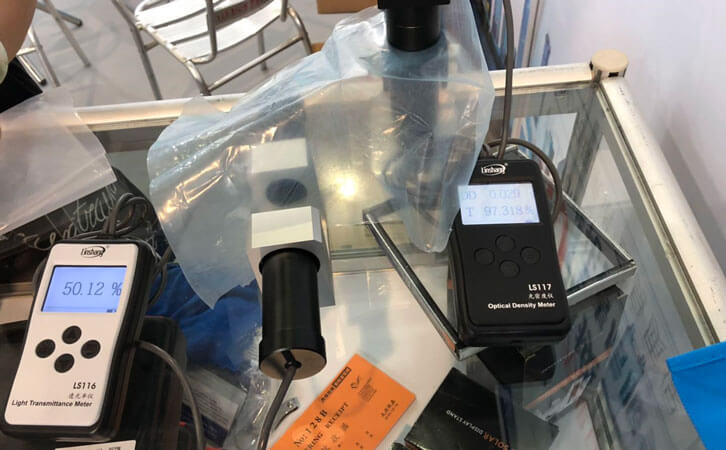How to Increase Greenhouse Film Light Transmittance?
The visible light transmittance of greenhouse film will decrease, due to pollution, water droplets and dust. If the visible light transmittance of the film is poor, the photosynthesis of the crop will be seriously affected, which is extremely unfavorable for the growth of the crop. Regualr measurement of the VLT is necessary, light transmittance tester is developed for measuring the light transmittance of the agricultural film. Farmers take measures to increase the light transmittance of shed film, so what should be done? And how do we measure the visible light transmittance of the greenhouse film using transmittance meter. Let's take a look.
I. How to improve the visible light transmittance of agricultural film?
1. Cleaning
In order to improve the light transmittance of the shed film, in addition to designing the lighting angle and promoting the use of non-drip film during the construction, it should be cleaned every other week during use. So the dust and broken grass on the shed film can be cleaned up.
2. Dry fine soil or gypsum powder
During the cultivation process in the greenhouse, there is no high humidity in the greenhouse. Any water droplets will adhere to the greenhouse film, which will also affect the light transmittance of the greenhouse film. Before laying, you can sprinkle fine soil or gypsum powder on the shed film. Then wipe it with a towel or cloth repeatedly for several times, then wipe it clean. Treat the treated side inward, which can reduce the adhesion of the shed film water droplets.
3. Spray soybean powder
Drying fine soil or gypsum powder can only be maintained for a period of time, after which there will still be water droplets attached, then you can grind the soybean into a fine powder. Use 7.5-10 grams of soybean powder per square meter of greenhouse film, 150 grams of water, soak After 2 hours, filter with fine gauze, remove the scum, and spray the water droplets on the shed film with a sprayer. In this way, the water droplets can fall quickly and it can be kept for about half a month without forming new water droplets.
4. Turn over the greenhouse film
You can choose a no-wind, sunny noon, remove the film and turn it over, so that the original upward side is facing down and then fix it. This can also reduce the adhesion of water drops and greatly improve the light transmittance.
II. How to choose greenhouse film with different colors?
Agricultural mulch is the ground cover film, usually transparent or black PE film, with a thickness of about 0.008~0.015 mm. It is mainly based on the different reflection and absorption principles of various light to increase soil temperature, maintain soil moisture and maintain soil structure to prevent weeds, pests and diseases. The function and light transmittance of the mulch film of different color thickness are not the same.

1. Colorless and transparent agricultural film
Colorless and transparent mulch film is also called ordinary mulch film, because it is easy to form fog droplets in the film which will affect the light transmission, it is also called drip film. The thickness is about 0.015 mm and the width is between 80-300 cm. It has the best light transmittance and its light transmittance and thermal emissivity are over 90%.
2. Black greenhouse film
The black mulch film is not very light-transmitting. It can avoid soil moisture loss and curb weeds during use. In addition, due to the low light transmittance, the poor temperature-raising effect can reduce the surface temperature and maintain humidity. The visible light transmittance of the black mulch is only 1% to 3% and the heat radiation is only 30% to 40%.
3. Silver gray mulch
The silver-gray mulch film can repel aphids, prevent viruses and protect moisture, as well as weeding. The light transmittance of the silver-gray mulch is 15% and the light reflectance is higher than 35%.
In addition to color, the material of agricultural film is also an important factor affecting visible light transmittance. The light transmittance of domestic PE film is 85%-88% and the light transmittance of PE film imported from abroad is 88%-91%. The light transmittance of Po film is higher than that of PE film, which can reach 92%-97%.
The light transmittance of agricultural film can be measured with LS116 light transmittance meter. Put the film into the measuring notch and the visible light transmittance of the film will be displayed immediately. This is a professional instrument for measuring the light transmittance of uniform light-transmitting materials. It adopts a parallel light path design. LS116 light transmittance meter can be used to measure the light transmittance of glass products, window films, laminated glass, coating materials, organic material panels and other materials. It is suitable for various occasions such as exhibition, production, quality inspection and inspection.
For more related knowledge and light transmittance testers, you can view more details in Linshang official website.
- Linshang Insulated Glass Unit Measuring Tools
- Spectacle lens anti-blue light detection---blue-violet light transmittance meter
- Measurement of Optical Density
- Difference of LS116 Transmission & LS117 OD Meter
- Difference between LS116 and LS117 Light Transmittance Meter
- What’s the Difference Between Point Light and Parallel Light Transmittance Meter
